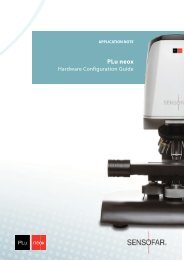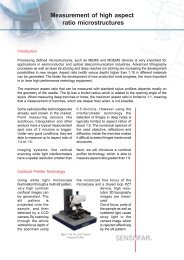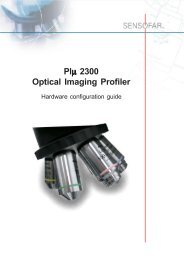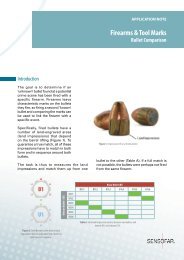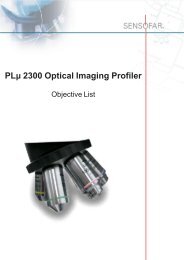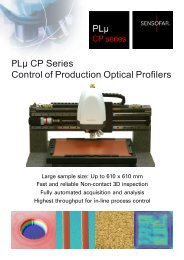3D Optical Profiler - ST Instruments
3D Optical Profiler - ST Instruments
3D Optical Profiler - ST Instruments
You also want an ePaper? Increase the reach of your titles
YUMPU automatically turns print PDFs into web optimized ePapers that Google loves.
SY<strong>ST</strong>EM PERFORMANCE Microdisplay-basedconfocal scanning Integrated spectroscopic reflectometerPractical limits for confocal and interferential methods for film thickness measures are to the order of 1 μm, and limited to a singlelayer. The neox incorporates a spectroscopic reflectometer through an optical fiber for the measurement of thin films, with thicknessesranging from 10 nm and up to 10 layer stacks. The optical fiber is imaged through the microscope’s objectives. Thus, thin films can bemeasured with spots as small as 5 μm. The measurement is undertaken with the integrated LED light source, which provides real-timebright-field images of the sample and simultaneous thin-film measurements. Color CCD cameraExisting confocal microscopes use mirror scanning heads,which are movable mechanisms that limit lifetime anddegrade pixel dithering at high magnifications. For confocalscanning, the neox uses the Sensofar’s patented technology,which is based on a microdisplay. The microdisplay isbased on ferroelectric liquid crystal on silicon (FLCoS), afast switching device with no moving parts that makes thescanning of confocal images fast and very stable with anunlimited lifetime.Diffraction-limited structures of 0.2 μm.Courtesy of Obducat technologies.www.obducat.com Dual LEDTwo high-power LEDs are integrated into the light source. A white LED is used for color brightfieldinspection, thin-film metrology, VSI and ePSI, and a blue LED is used for high-resolutionconfocal imaging and PSI. The short wavelength of the blue LED increases the lateral resolution to0.15 μm (L&S) and improves PSI noise to 0.01 nm of vertical resolution. An objective lens for each applicationThe neox uses premium CFI60 Nikon objectives lenses, which have the largest working distancefor each NA. Over 50 lenses are available. Each one suits a specific application: high NA is usedfor confocal imaging and profiling, with a magnification range of 2.5X to 200X, super-longworking distance, extra-long working distance and water immersion objective lenses; collarring adjustment for focusing through transparent media up to 2 mm thickness; and interferential objectives lenses of 2.5X to 100Xmagnification, with reference mirror correction and incorporated tip-tilt.The neox uses a black and white, high-speed, high-resolution CCD camera as the system’smetrological detector. A color camera can be used for bright-field surface inspection. Thismakes it easy to identify the features of the sample under analysis. In addition, an infinitefocused color image can be obtained from topography measurements. The system acquirescolor images during vertical scanning and assigns to each pixel the color of the imageobtained at the z position where the surface was in focus. The infinite focused color imagecan be used to create impressive <strong>3D</strong> views of the measurements. Dual vertical scannerThe dual vertical scanner consists of a motorized stage and a piezo forthe highest scanningrange and the highest measurement accuracy and repeatability. The linear stage hasa 40-mm travel range and high position accuracy. Steps as smallas 10 nm can be made, which is ideal for confocalscanning.Other objective lenses for specific applications are also available.Please visit www.sensofar.com for more information. High speed (12.5 confocal fps)The fast switching speed of the FLCoS microdisplay and proprietary confocal algorithmslead to a confocal rate of 12.5 confocal images per second. Due to this high frame rate,vertical <strong>3D</strong> scanning is performed at 8 planes/s, which means that the scanning speedfor confocal <strong>3D</strong> measurements ranges of 0.5 to 350 μm/s. Interferential scanning andprofile measurements are performed at 50 fps, which means that the vertical scanningspeed is up to 800 μm/s. A typical measurement time that includes calculations afterthe scan is less than 5 seconds.The integrated piezo scanner has a range of up to200 μm, with piezo resistive sensors for high positionresolution of 0.2 nm and 1 nm of accuracy cy on the fulltravel range. Existing scanning stages with an opticalencoder have 30 nm of uncertainty, which limitssystem repeatability and accuracy.The neox, with its unique combination ofa linear stage and a piezo scanner, has thehighest accuracy, linearity and repeatability ityon the market, with a measurement rangefrom 0.1 nm to several mm.10 nm step heightand dental implantInk dots on stamp




